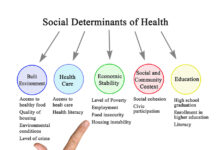A team led by Daryl Sweet of Queen’s University Belfast completed an exploratory study mapping personal well-being networks for individuals with SMI diagnoses. The researchers expanded on previous social network research to create maps that include not only social relationships but also connections to community places and involvement in meaningful activities. They propose that their work, published recently in the British Journal of Psychiatry, may eventually be used to support person-centered, recovery-oriented interventions for those diagnosed with SMI.
“Place locations and meaningful activities are important aspects of people’s social worlds,” the authors write. “Mapped alongside social networks, personal well-being networks have important implications for person-centered recovery approaches through providing a broader understanding of an individual’s lives and resources.”

As the authors explain, prior research has shown that individuals with severe mental illness (SMI) diagnoses have more limited social networks – both in the number of connections and strength of emotional ties – than the general population. Past research in this area has typically defined networks solely in terms of the number of social relationships and has explored factors related to social network size. For example, one study found a link between more extensive social networks and decreased rates of hospitalization.
Sweet’s study is novel in its inclusion of other elements (e.g., place and activities) into a social network map that may help provide a fuller picture of participants’ social lives and resources. The team’s decision to include these components was informed by a recently developed personal recovery framework that identifies “connectedness and meaningful activities” as crucial components of recovery journeys.
To develop and analyze personal well-being network maps for individuals with SMI, the researchers collected data from a non-representative sample of 150 participants at two sites in England. All participants were between 16 and 65 years old and had a primary diagnosis of schizophrenia, bipolar, or other psychoses.
The research team used a name-generator method to collect data from participants about the people, places, and meaningful activities (participant-defined) they identified as contributing to their well-being. Information about the frequency, length, and emotional intimacy of relationships was also collected, as were measures of well-being, social capital, and physical health and social functioning. The data was then visualized using a personal well-being network map developed for the study.
Key results included:
Identification of three personal well-being network types:
Based on their analysis, the researchers identified three personal well-being network types – ‘formal and sparse,’ ‘family and stable,’ and ‘diverse and active.’ 31% of participants fit under the ‘formal and sparse’ network type, which was characterized by relatively fewer social connections, a larger proportion of medical provider contacts, more time at home, and fewer links to community places and involvement in meaningful activities. Those with ‘formal and sparse’ networks tended to be older, recipients of long-term disability aid, and to have schizophrenia or a psychotic disorder diagnosis. They were also more likely to be male.
32% of participants’ networks were classified as ‘family and stable,’ meaning that their social worlds were primarily composed of family and friend relationships, as well as more “emotionally close” and steady connections. Although these individuals spent the majority of their time at home, they also had some “community place connections,” and meaningful activity participation. Members of this group were more likely to be female, diagnosed with bipolar disorder, and employed (full or part-time).
Lastly, 36.7% percent of participants fell into the ‘diverse and active’ network group. Those in this group had relatively more social connections as well as greater “relationship type” diversity (i.e., both strong and weak ties, such as neighbors, co-workers, and acquaintances). ‘Diverse and active’ network members spent more time outside the home and were tied to more community places and involved in more meaningful activities than those in other groups. Participants in this category also tended to be younger and more educated than the other two groups.
“Small but significant differences” in mental well-being scores, and significant differences in “self-rated overall health” were found between types, with ‘formal and sparse’ group members experiencing the lowest scores and ‘diverse and active’ exhibiting the highest scores in both cases. However, the authors also underscore their findings of within-group variation – in particular, connectedness, well-being, and quality of life (as measured by physical health and social functioning) were found to highly vary within each of the three network types.
The significance of place and activities:
The authors argue that including place and activity data in an individual’s social map provides a more textured understanding of his or her social world, which can allow health care providers to more effectively identify strengths and possibilities for growth. For example, they discuss the map of one participant who, on the basis of social ties alone, seemed isolated; after incorporating place and activity data into this person’s map, however, it became possible to see that s/he was in fact connected to some places and related activities (e.g., the park, going for walks). Such discoveries could offer practitioners a foundation on which to help patients build further resources, as well as a point of entry for a conversation about resource-building opportunities.
The authors note that their findings are limited in that they are not based on data from a representative sample of individuals with SMI. They are also careful to explain that the three network types they identified are not conclusive, but instead, exist relative to each other. They emphasize that research with other samples could result in the identification of different types.
“Mapping an individual’s PWN [personal well-being network] could support person-centered approaches, both for understanding individuals’ decisions and co-producing plans to change networks in ways that enhance recovery and well-being,” Sweet and his colleagues write.
In closing, the authors write that their expanded approach to understanding the social networks of individuals with SMI diagnoses may enhance practitioners work with patients. They suggest that this method may offer possibilities for developing personalized, “recovery-focused practice.”
****
Sweet, D., Byng, R., Webber, M., Enki, D. G., Porter, I., Larsen, J., … & Pinfold, V. (2017). Personal well-being networks, social capital and severe mental illness: exploratory study. The British Journal of Psychiatry, bjp-bp. (Link)















How embarrassing that you must educate today’s “mental health professionals” of the “Importance of Social Networks for Psychosis and Bipolar Interventions.” Although I know it is mandatory you educate the “mental health professionals” about this, because they are very deluded about the importance of honoring the rights of other people, to live their own lives.
My psychologist very literally told me, “give up all your activities and concentrate on the meds!” in a manic lunatic manner. I knew that was insane advice. Talking to “mental health professions” was insane in general, I found them to be the most delusional and ungodly disrespectful people in the world.
Volunteering and hanging out with my friends and family was where I found sanity. But my psychologist’s insane advise to give up all my activities is proof the “mental health professionals” are insanely stupid people who do need to be educated about the importance of honoring other people’s right to maintain their social networks.
I will mention that “developing personalized, ‘recovery-focused practice'” is not in the financial best interest of today’s “mental health professionals,” and never will be. So I’m pretty sure it’s just rhetoric.
Report comment
Before psychosis and hospitalization I was a popular guy with plethora friends. It was fun but it wasn’t really that fantastic.
I started telling myself why not see what life feels like with nobody in my life. This saying helped me to come to grips with this. It was often hard especially when I was teenager and in twenties but I got used to it and then liked it
I like it even more now. Later on as I got older and have professional career I began to see more people flocking to me.
Report comment
A great perspective. Goes to show that people with the exact same “diagnosis” need totally different things. What works for one won’t work for the next. Which makes me wonder what the meaning of the “diagnosis” is, if diagnosis doesn’t tell you what you should do to help. But well done to you for finding your way, Pat, because of or in spite of outside efforts to help. It is a very personal journey.
Report comment
“…identifies “connectedness and meaningful activities” as crucial components of recovery journeys.” But wait, I thought it was all about brin chemistry!
Report comment
The loony “mental health professionals” do believe it’s all about “chemical imbalances” in people’s brains, that’s part of why they are so delusional. But they believe stigmatizing people with their made up and scientifically invalid DSM disorders, while also screaming that people shouldn’t be stigmatizing others, is rational behavior also.
Report comment
Are they talking about stuff like Facebook when they say “social network”? (I hope not.)
Report comment
Beyond question, psychiatrists are the most well-educated stupid people, and the stupidest well-educated people, EVER! Cutting through all the college-level jargon and acronyms, the whole article boils down to, “healthier people have more friends than sicker people, so let’s look at that!”….
The current so-called “mental health system” is a PROCESS-centered process, and a SYSTEM-centered system.
They use whatever process most benefits the system, and whatever system works best for *THEIR* process.
If we could move to a PERSON-centered process, and a SERVICES-centered system, we *might* see some progress. But don’t hold your breath. The pseudoscience drug racket, and means of social control known as psychiatry, simply makes TOO MUCH $$$$ for it’s bosses, – PhRMA, – to make any major changes too quickly. They *LOVE* that “SMI” label, and the STIGMA it imposes on vulnerable persons!….
Psychiatry belongs on the scrap-heap of history, along with Freud, and Phrenology….
That great CATALOG of BILLING CODES, the DSM-5, makes better COMPOST than anything else….
Psychiatry has done, and continues to do, far more harm than good. When the psychs admit *THAT* truth,
that will finally be some good news…. We can dream, can’t we?…..
Report comment